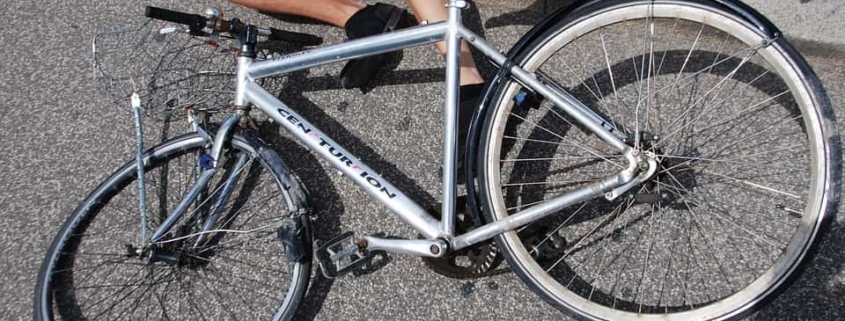CDC Reports an Increase in Bicycle Injuries and Deaths for Adults
During our recent COVID-19 shutdown, many Americans decided they would spend more time outdoors. After all, there were no restrictions on getting exercise, and with many offices shut down, the extra time and a need to stay healthy with exercise meant more outdoor activities. But there has been a corresponding increase in the number of severe injuries and deaths among adult bicyclists.
Outside Magazine estimates 675 bicyclists died in 2020, even as there was a sharp reduction, by as much as 41 percent, in the amount of automobile traffic on our roads.
That is only a slight drop from the deadliest year for bicyclists, 2018, when 871 adult bicyclists were killed, according to the National Highway Traffic Safety Administration (NHTSA).
A cyclist is no match for an automobile, especially as many vehicles are now larger SUVs being driven recklessly by someone checking their cell phone.
Most patients treated in the emergency room for a traumatic brain injury (TBI) recover; however, some patients have ongoing symptoms of emotional, cognitive, and behavioral complications.
In a newly released report, the Centers for Disease Control and Prevention (CDC) reports that bicycling leads among sports-related injuries in the most significant number of emergency department visits for TBI. The CDC report tracked the number of emergency room visits between 2009 and 2018, collecting data on almost 600,000 ER visits.
The CDC estimates that in 2019, there were nearly 61,000 TBI-related deaths. A fall to the sidewalk, collision with the vehicle, or any impact to the skull result in a TBI. Falls lead to almost half of TBI-related hospitalizations, reports the CDC.
The rates of head injuries for adults on bikes were already of concern.
Between 2009 and 2018, there were nearly 600,000 emergency room visits for bicycle-related TBIs. Gender was also a factor. Perhaps not surprisingly, males were three times more likely than females to end up in hospital emergency departments with traumatic brain injuries (28.8 and 9.2, respectively).
Most bicycle crashes with a motor vehicle occur within one mile of the biker’s home.
The Good News – Childhood Injuries from Bicycles
There is some good news to report about TBI incidents during this period. During the same time, there has been a sharp decline in the rates of head injuries among children riding bicycles.
The rate of emergency room visits for TBI decreased by almost half among children age 17 and younger. That far exceeds the improvement for adults, which fell by only 5.5 percent. That means children’s head injuries declined at a rate nine times greater than adult bicycle-related head injuries.
An improvement is seen in severe head injury rates among children ages 10-14. It’s estimated that bike helmets reduce the risk of head injury by as much as 85 percent and brain injury by 88 percent. The CDC attributes the improvement in head injury to expanded comprehensive bike safety interventions such as helmet use, dedicated bicycling lanes in cities protecting cyclists from traffic, and improving compliance with traffic laws.
In the future, more focus is need to improving roads with a focus on pedestrian and bicycle safety.
Helmet Use
Helmet wearing alone is believed to be responsible for a 20-55 percent reduction in bicycle-related head injuries and TBIs.
Bicycle helmets alone are not designed to prevent a concussion, but they will help reduce the risk of a head injury and a traumatic brain injury (TBI).
Considering the injuries associated with bicycles, using the correct bike helmet can absorb much of the impact during a fall or collision that the skull or brain might take without a helmet, however, not just any helmet. The standard for a safe helmet that the Consumer Product Safety Commission (CPSC) issues must be stated in the label found usually on the liner inside the helmet.
Besides wearing a helmet, it’s also essential to make sure it fits correctly, which means it should be snug and free of any cracks or missing parts or pads. The chin strap should be in place. The manufacturer’s instructions accompany any new helmet.
The CDC concludes more education about bicycle safety is needed and primarily targeted at the male rider, especially as more Americans are deciding to commute to work on bicycles.
The CDC study appears in the journal Morbidity and Mortality Weekly Report, published May 13th.
CPSC
Meanwhile, the Consumer Product Safety Commission (CPSC), in its recent report on COVID-19-related hospital emergency room visits, found overall, during much of 2020, emergency department visits for relatively minor injuries decreased 41 to 50 percent while severe injuries requiring hospitalization decreased only one percent.
Bicycle-related injuries had a slight increase among all injuries, but a 21 percent jump among those ages 40 and above compared to the previous year.
In 2020, not unexpectedly, organized sports-related injuries saw a dramatic decrease, however, there was a 39% increase in 2020 from injuries related to skateboards, scooters, and hoverboards. Waterskiing, chainsaw injuries, hot tubs, and fireworks also saw a substantial jump in the number of injuries from the year before.
There was also an increase in patients who died in emergency rooms due to product injuries rising from 5,045 in March 2020 to 5,549 in September 2020.
If you or a loved one got injured or killed in a bicycle accident that was someone else’s fault, get in touch with a local personal injury lawyer to discuss your rights and legal options.




Leave a Reply
Want to join the discussion?Feel free to contribute!